 Photo 1
Photo 1
There are numerous options open to the framer when it comes to materials for canvas transferring.
Throughout the 90s customer awareness has created an increasing demand for art images that represent the look and feel of original paintings, while still maintaining the economy of an inexpensive duplicate. I first wrote about the process of canvas transferring in Photos to Canvas to Cash, 1991, but the process has been used throughout the photographic industry for many years prior to that. It has only been during the past 5 years that canvas has really begun to make an impact on the framing industry. Through both open edition publisher runs, and the Gicleecraze, canvas transferring (aka canvas bonding) and canvas imaging is stronger than ever.
Respecting Copyrights
Regardless of whether the image selected for transfer is to be completed in-house or sent out to a commercial company, the issue of copyright remains at the core of the project. Any open edition poster print or studio portraiture must have the approval of the artist or publisher prior to transferring to canvas.
Currently it still remains legal to offer the service of canvas transferring to a customer, but it is not legal to purchase a series of prints specifically with the intent of transferring them for display and resale in your gallery. Because of the volatility of the copyright issue, most likely all states will eventually end up establishing their own precedents concerning this topic. If an open edition image is available from a publisher as either a print or canvas image, when a customer requests canvas it must be purchased that way and may not be transferred by a framer. The express consent of the artist, photographer or publisher must be obtained prior to transferring, for only then will all royalties and acknowledgements be made.
The entire issue comes back to the original artist and publisher having ownership of the image and the right to control the form in which it is displayed. Despite copyright laws, it has become increasingly difficult to prevent illegal infringement of artwork. Photocopiers and computer scanners have made it easy to duplicate, modify and enlarge pages from books and catalogues, encouraging creative framing practices by transferring them to canvas. Copyright infringement is an illegal practice, and ignorance is no excuse. For additional information on copyright issues contact the —Lawyer for the Artsoffice in your state.
In-House Application or Commerically Done
There are numerous commercial companies available offering the service of transferring. They too will be concerned with copyright and may require permission prior to completing a given job, or may be forced to refuse a job due to copyrights. They often offer everything from the initial transfer, to stretching, aging, crackling, and adding brush strokes, all for an extremely reasonable price Commercial prices for transferring will vary with companies, but all are competitive.
There are a couple of things that set in-house transferring apart from commercial. First, is the technique itself. Commercial transferring is often done chemically, whereas in-house it may be achieved with a heat press and laminating film, or acrylic coatings and a cold frame. Second, is turn around time. When completing a project in your own shop it can technically be completed the same afternoon the order is taken if all materials are on hand.
Materials and productions costs will also vary when working in-house. Just as buying length moulding or mat board in volume, purchasing canvas and laminates in rolls will greatly reduce the cost per square foot. Check with individual distributors for material prices.
Generally the retail charges to a customer will run as low as $1.50 per united inch (UI), but add to that $.50 UI for stretching, plus $1 UI for brush strokes, the transfer easily reaches $3 UI and often runs upwards of $5 UI, depending on the market. So an 11"x14" in-house transfer has hard costs of under $5, while it retails for $75-$125. And remember, this is all prior to moulding and fitting charges.
Surface Laminates and Techniques
In past issues I have covered the step-by-step application and transfer of laminate to canvas. For addition information or review see —Photos to Canvas to Cash—, or 3-part series "Canvassing Photos, Projects and Paper Prints", October, November, December 1994. It is also available in my book The Mounting and Laminating Handbook, available through PFM. This time, however, I want to discuss the various materials and options when transferring in-house rather than the process (photo 1).
 Photo 1
Photo 1
There are numerous options open to the framer when it comes to materials for canvas transferring.
The surface laminates used are linered vinyl available on rolls. It is the same film used over posters and photographs as a substitute when glass is not desirable or allowed. Smooth finishes (Gloss, Satinex, Luster, Super Matte, Satin Matte, Matte, Mattex, Ultra Matte…) rather than textures are preferred so the pattern and threading patterns of the canvas substrate will be allowed to press through the decal from the back. Textural films (assorted products include Canvas, Deep Canvas, Fine Linen, Coarse Linen, Sand, Canvastex, Linentex, Emerytex…) have more tendency to fight with the actual fabric it is mounted to and becomes more distracting than visually enhancing. The determining factors in selecting your laminate will most likely be price, convenience, manufacturer, distributor technical service, and whether you want the roll perforated or prefer to hand perforate for select projects.
Canvas Textures and Weights
There are numerous canvas textures available through many manufacturers as seen in photo 1, and one manufacturer may offer more than one weave such as or color (photo 2a/2b). Textures will vary from coarse to fine weave (photo 3) which is determined by the thickness and/or tightness of the threads in the fabric. These patterns also vary from knobby uneven threads to even refined threads (photo 4), which create a more even appearance to the transfer.
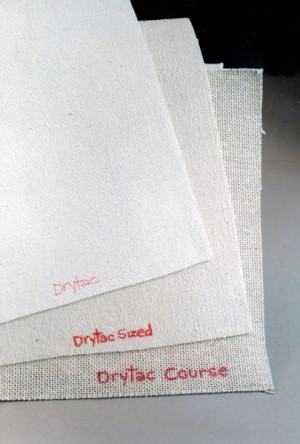 Photo 2A
Photo 2A
Various textures and colors of canvas may be available from one manufacturer, check with your distributor for availability.
 Photo 2B
Photo 2B
Selection of a weave pattern is often a matter of individual taste. Some people, and often artists, prefer, very even symmetrical patterns in the canvas, while others enjoy the lumpy uneven asymmetry of knobby threads. There is no right or wrong, it is purely subjective. The only thing to watch out for is using knobby textures under portraits, this is when the biggest lump in the canvas always ends up in the middle of the subject's face.
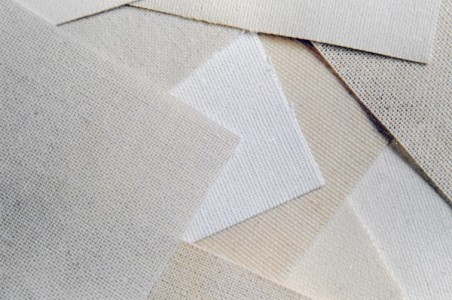 Photo 3
Photo 3
Coarse to fine weave canvas, and everything in-between, may be found. Shop around if you are looking for specifics in pattern and color.
Canvases are also available in various weights. Generally 10oz. or 12oz. cotton are found in the framing and photo industries. These canvases may sometimes feel thicker when it—s actually not the fiber weight but the stiffness of the fiber that is the determining factor. Stiffness or fabric body is also determined by the addition of sizing, a stiffener added to natural soft fibers. It only stands to reason the more a naturally soft fiber is bleached, sized and treated the stiffer it may become. This makes some canvases more difficult to stretch.
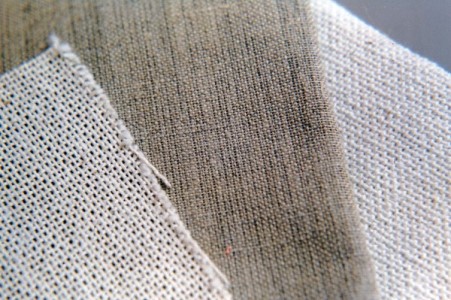 Photo 4
Photo 4
This detail of natural colored fabrics illustrates (from left to right) Modern, raw linen, and Traditional canvas. (Modern and Traditional are the company names for these patterns.)
The Colors of Canvas
Canvas, regardless of its weave, is available in various colors. In its natural state, raw canvas is generally (photo 5) a neutral cream color and often unbleached. It is also found bleached and white. Even natural cream and white colors can vary. There are bright cold, hard whites and warmer grayer whites (photo 6).
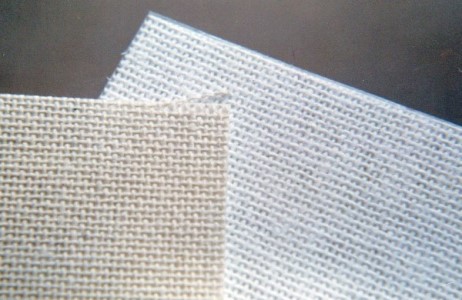 Photo 5
Photo 5
These are both Modern canvases of the same thread pattern, only the left sample is natural cream while the right sample is bleached white.
White canvas is required when transferring wedding portraits or light posters to canvas. Darker natural colored fabrics will color tint through stripped decals darkening the white highlights making whites appear dingy. White canvases are available as bleached natural or natural cream fabrics are sometimes painted with a white HA adhesive or may be acrylic gessoed with white as a size to alter the natural color.
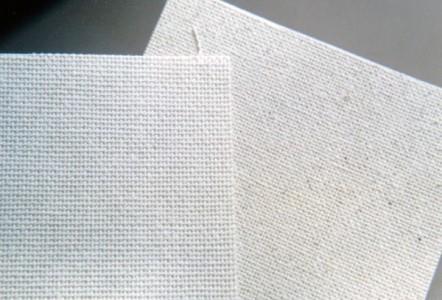 Photo 6
Photo 6
The two canvases show an open weave cold bright white on the left, and an uneven weave of a softer grayer white on the right.
The process used to alter the canvas color will definitely effect the stiffness of the resulting transfer for later stretching.
Adhesives and Canvas
If specially treated, sized, variable thread weights, weave patterns, and/or colors are desired for transferring in order to truly customize transferring, then sometimes material sources outside the framing industry may need to be enlisted. Within the industry there are numerous companies offering both natural and white canvases, many in raw and HA varieties.
Raw or uncoated canvas is also available from some manufacturers (Drytac and McDonalds) as well as local art stores, and fabric shops. They may be prepared for transferring by applying commercial wet glues to their surface such as Acid Free Mounting Glue (Hot Press), then mounting the peeled print or photo to it with a cold vacuum frame. There are also heat activated (HA) wet glues that may be applied, allowed to dry, thereby preparing the raw surface for later bonding with a peeled laminated print or photo in a mechanical dry mount press, or heat vacuum system. Wet glues that have been proven to be activated by the application of cold vacuum or heat include Berto (Corona), Lamin-all (McDonalds), VacuGlue 300 (Seal), and LION Liquid Heat Seal Adhesive (LION UK).
It is also possible to use raw canvas and HA film adhesive (Fusion 4000, Flobond…) in a heat press either mechanical or vacuum. The potential for wrinkles, however, during bonding greatly increases due to the multiple layers of untacked materials (stripped decal, adhesive, canvas) all being allowed to shift or crease during vacuum draw. One solution is to bond the adhesive first to the decal, then in a second mounting to the canvas thereby eliminating some of the loose layers.
Heat activated (HA) or coated canvas is raw canvas that has already been commercially coated with an adhesive which bonds the transfer to the fabric when placed within a heat press. These may be found as both tacky adhesives with a liner applied to protect the adhesive from dirt, and unlinered with a dry coated adhesive (photo 7).
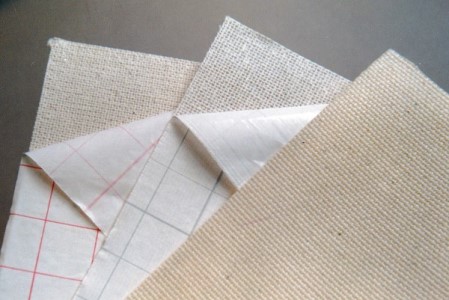 Photo 7
Photo 7
The two left adhesives are linered natural and white. Though it's tough to tell, the right sample is a plain unlinered heat activated coated canvas.
The advantage of the linered products (Seal, Hot Press) are the light tack that helps hold the decal in position on the canvas during set-up, placement into the press, and during draw of the vacuum. Since the canvas has a temporary P-S tack for positioning it becomes a bit more user friendly and reassuring during bonding.
Nonlinered HA coated products (Drytac, Seal, MacDonalds) have the potential for decal shifting during the transfer bonding process within the vacuum press. If the surface laminated stripping process has been used to prepare the poster or photo for stripping, the peeled decal has a slight tackiness remaining on the back of the laminate. This will help hold the stripped decal in position during final bonding.
Wrap Up
Once the materials have all been selected and matched to the desired hot or cold system, it is simply a matter of promoting the concept and selling the service. Canvas transferring is a natural addition to any photographer or framer's offered custom services. It will increase specific custom sales while also raising the average ticket sale and profit dollars.
Just as with laminating and other creative applications, this process may need to be promoted to launch its campaign through advertising, sales counter promotion and in-store framed samples, but the interest in canvas transferring also comes straight from the customer. This is an age of image, and desire for originals. What better to sell than something your customers are already clamoring for.
END
Copyright © 1998 Chris A Paschke
For more articles on mounting basics look under the mounting section in Articles by Subject.
Additional information on all types of mounting is found in:
The Mounting and Laminating Handbook, Second Edition, 2002,
The Mounting And Laminating Handbook, Third Edition, 2008 and
Creative Mounting, Wrapping, And Laminating, 2000 will teach you everything you need to know about getting the most from your dry mount equipment and materials as an innovative frame designer.
All books are available from Designs Ink Publishing through this website.
Chris A Paschke, CPF GCF
Designs Ink
Designs Ink Publishing
785 Tucker Road, Suite G-183
Tehachapi, CA 93561
P 661-821-2188
chris@designsinkart.com